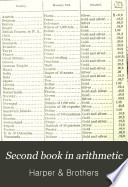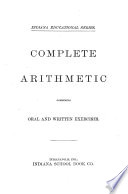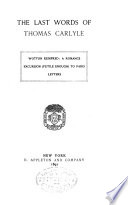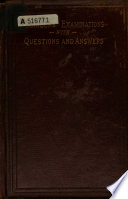 | Arithmetic - 1882 - 392 pages
...term is to be less than the third term. III. To find the fourth or required term :— Multiply all the second and third terms together, and divide the product by the product of the first terms. Adapt remarks a, b, after rule for simple proportion, 164, to apply to... | |
 | James Gray - Arithmetic - 1883 - 154 pages
...which stand below each other, which will reduce them to three ; then multiply the second by the third, and divide the Product by the first, the Quotient will be the answer in the same name with the third term. PROOF. Invert the question. 1. If 100Z. in 12 months gain... | |
 | James Bates Thomson - Business mathematics - 1884 - 344 pages
...second term; but when less, place the smaller for the second term, and the other for the first. III. Multiply the second and third terms together, and...first; the quotient will be the fourth term or answer. NOTES.—1. The factors common to ihe first and second, or to the first and third terms, should be... | |
 | Thomas Hunter - Home schooling - 1884 - 670 pages
...the second term and the greater for the first. Multiplying the third term by the second and dividing the product by the first, the quotient will be the fourth term or answer. Compound Proportion, or the double Rule of Three, is applied to the solution of questions requiring... | |
 | Edward Sylvester Ellis - Arithmetic - 1889 - 370 pages
...than the first. If the fourth term will be less than the third, make the second less than the first. Multiply the second and third terms together and divide the product by the first : the quotient is the fourth term, or term required. To TEACHER. — Proportion, formerly known aj the Rule of Three,... | |
 | 1892 - 788 pages
...to that, and the whole problem of existence is easy and certain as a question in the Rule of Three. Multiply the second and third terms together, and divide the product by the first, and the quotient will be the answer ! Trust me, friend, before you come to my time of day, you will... | |
 | Thomas Carlyle - Authors, Scottish - 1892 - 406 pages
...to that, and the whole problem of existence is easy and certain as a question in the Rule of Three. Multiply the second and third terms together, and divide the product by the first, and the quotient will be the answer ! Trust me, friend, before you come to my time of day, you will... | |
 | Thomas Carlyle - 1896 - 522 pages
...to that, and the whole problem of existence is easy and certain as a question in the Rule of Three: Multiply the second and third terms together, and divide the product by the first, and, the quotient will be the answer. Trust me, friend, before you come to my time of day, you will... | |
 | Thomas Carlyle - Clothing and dress - 1897 - 508 pages
...to that, and the whole problem of existence is easy and certain as a question in the Rule of Three : Multiply the second and third terms together, and divide the product by the first, and the quotient will be the answer. Trust me, friend, before you come to my time of day, you will... | |
 | Nehemiah Hawkins - Steam engineering - 1898 - 230 pages
...of the two remaining numbers for the second term, and the greater for the first ; and in either case multiply the second and third terms together, and divide the product by the first for the answer, which will always be of the same denomination as the third term. NOTE.— If the first... | |
| |